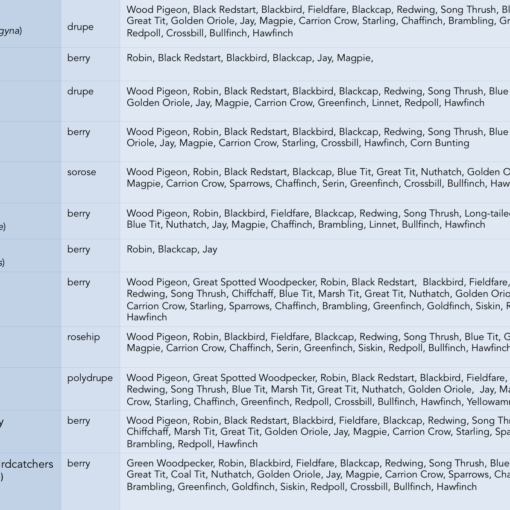The July sun, with its long days, allows many fruits to ripen, helping birds and mammals feed their new families.
Walking in wooded areas, we can find a close relative of the cherry trees described in the June article. It is the Rock Cherry (Prunus mahaleb), of the Rosaceae family, a deciduous tree-shrub native to southern Europe, present in all regions of Italy except Sardinia. It grows from sea level up to about 800 m (in Sicily, it reaches 1900 m) and is quite common in oak forests. Many consider this species a pioneer due to its preference for calcareous, poor, and often stony soils, as well as its ability to thrive even in exposed and sunny areas. It is often used to stabilize landslide-prone calcareous soils.
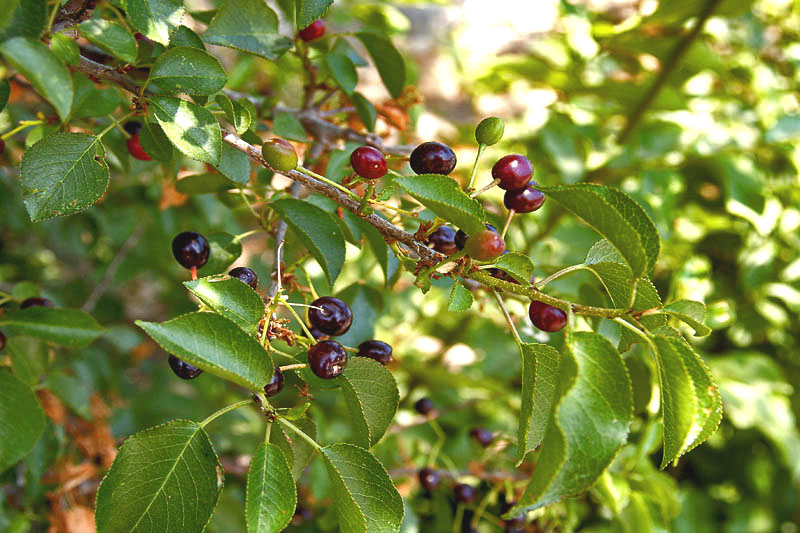
The Rock Cherry has a rather thick crown and is very branchy, with branches that are often thorny, erect and flexible; the flowers, weakly scented, are gathered in short corymbs of 4-12 flowers with a white corolla of 5 petals, and about 20 stamens with white filaments and dark yellow anthers. The fruits are globose drupes (8-10 mm), blackish-red, with a bitterish taste and a spherical, smooth central stone.
These fruits, although unpleasant in taste to humans, are loved by birds, which, by feeding on them, help the plant to disperse its seeds.
The whole plant contains coumarin, an aromatic compound used in the preparation of essences for liqueurs and perfumes and in the tanning of particular types of tobacco. The wood of the plant, due to its aromatic characteristics, is used to make pipes; it was also used, thanks to its hardness and resistance, for turning work and the manufacture of toys. The wild plant, rustic and robust, is often used as rootstock for cultivated cherry varieties.
Leaving the woods and heading towards uncultivated land, ruins, pastures, or cultivated countryside, from the plain up to 900 m, we often find the Black Nightshade (Solanum nigrum). This annual herb, in warmer climates (such as southern Italy), can become perennial, allowing it to develop into a subshrub with woody stems at the base.
Also known as Nightshade, Black Nightshade, Ballerina, or Black Grass, it grows up to 70 cm tall and has a generally ascending stem, which may be prostrate only at the base.
The flowers are white with a yellow star-shaped center and are grouped in pedunculated corymbs. They produce fruit that, when ripe, appears as hanging clusters. Each fruit is a small berry about 6-7 mm in size, initially green and then shiny black, divided into lobes containing discoid or kidney-shaped seeds.
In Italy, Black Nightshade is widespread throughout the country, including the islands, and has developed many local subspecies. It is considered a weed that can damage crops by competing for nitrogen and space.
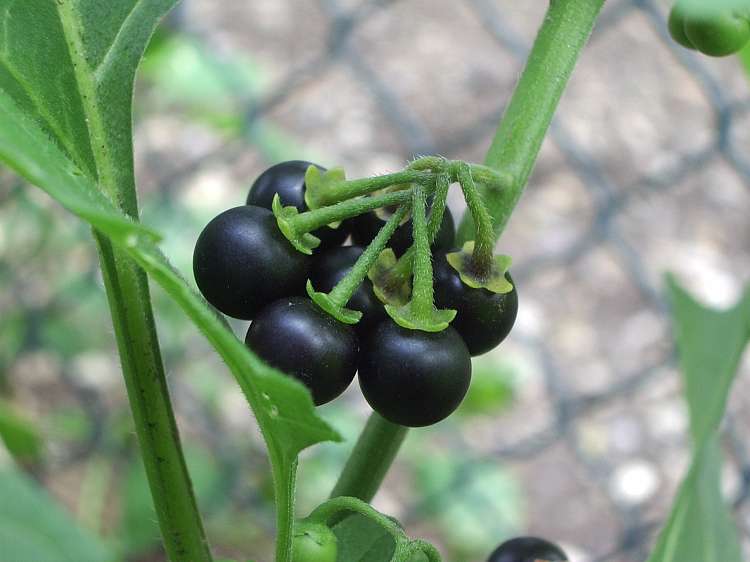
Like its congener Bittersweet, described last month, it is a dangerous plant: it contains toxic glucoalkaloids such as solanine, while the plant contains tropeine, rutin, tannins and various heterosides. The berries have caused many accidents to children attracted by their shine. They are deadly for dogs, sheep and rodents, so much so that in France it is also called “dog-cracking grass”. Lizards and tortoises, on the other hand, willingly feed on the ripe berries, which are evidently less toxic for them, or do not exert their action due to the different physiology of these animals. For this reason in Puglia and southern Italy, it is often called “snake tomato”. Even for birds, the berries of Black Nightshade are not toxic, highlighting the “kinship” between reptiles and birds, both considered “modern dinosaurs.”
It is in July that the last of the Ribes ripens: the Black Currant (Ribes nigrum), a shrub up to 2 meters tall that prefers loose soil, rich in humus and slightly acidic; it has deciduous foliage and branched stems. The leaves are large, flat, petiolate, with three to five lobes ending in sharp tips and serrated edges. The flowers appear in spring, arranged in hanging racemes; they are pentamerous, greenish-white in color, and not very showy. The fruits are black, globular berries rich in seeds, which ripen from late July to September. It differs greatly from the Red Currant, described last month, in color, aroma, flavor, and the use of the fruits. The leaves, buds, and fruits are intensely scented due to the presence of glands containing essential oils.
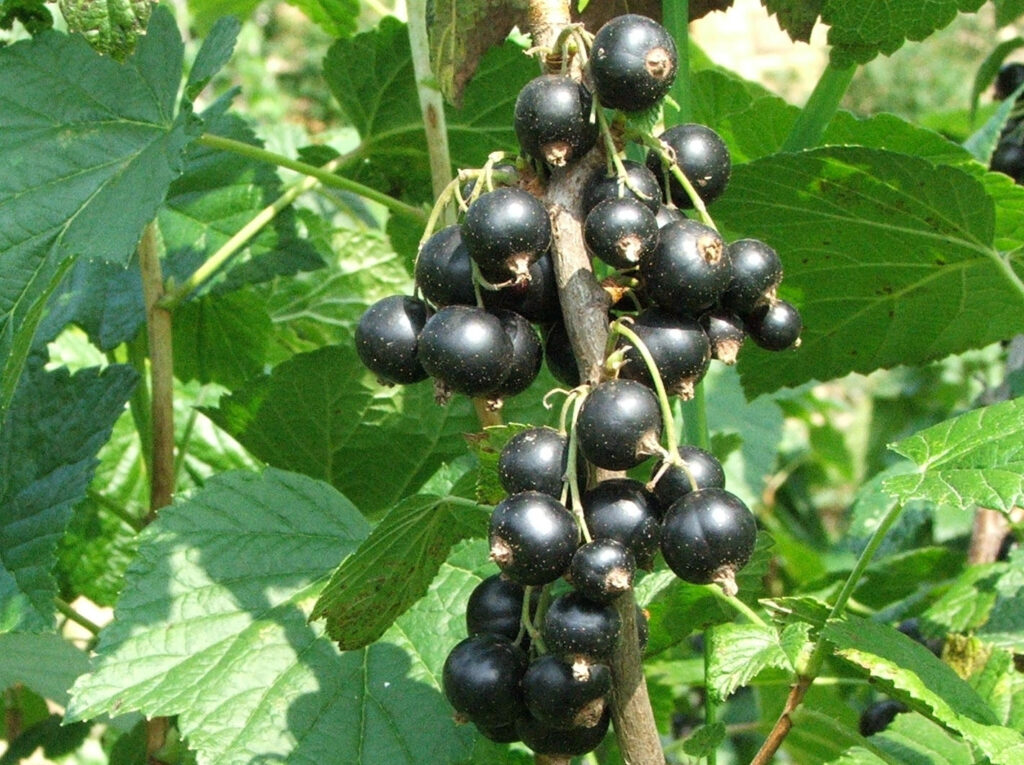
Wild blackcurrant is now very rare and is mainly cultivated for food purposes, but in recent years its therapeutic use has become increasingly popular. It is used in phytotherapy and gemmotherapy to stimulate the adrenal glands to produce cortisol, an endogenous cortisone that helps the body respond to inflammation. Also used for skin diseases, it promotes cortisol production, which triggers an essential reaction to any type of stress or injury. The fruits of this species are also the basis of Crème de Cassis (cassis is the French name for blackcurrant), a 20% ABV liqueur used to prepare kir by adding white wine.
We conclude this brief overview of the most well-known wild fruits with two species from the Viburnaceae family.
The first is found in the cool woods of valleys, along the banks of rivers and ponds, at the edges of humid forests, and on slopes. It quickly and aggressively occupies all free spaces in clearings, establishing itself as a “weed” even in highly anthropized and urbanized environments. It prefers fresh soils rich in nutrients and decomposed organic matter, thriving from the plains up to 1,400 meters in elevation: this is the Black elder (Sambucus nigra).
It is a tree, but more often a shrub, and can grow up to 10 meters tall, with a spreading, dense, and rounded crown. The trunk is erect, twisted, knotted, and irregular, heavily branched from the base, sinuous, and often bifurcated, with opposite branches that arch and droop. A distinctive feature of the branches and trunk is the white, soft, and elastic central pith, composed of spherical cells with thin cellulose walls. The roots are highly active and run near the surface.
The leaves are bright green, deciduous, 20-30 cm long, with an odd-pinnate blade made up of 5-7 ovate segments with pointed tips and toothed edges; when crushed, they emit an unpleasant odor. The small, highly fragrant flowers are grouped in pedunculated, umbrella-shaped inflorescences that can reach 20 cm in diameter, initially erect, then reclining. Each flower has a corolla of 5 ivory-white, sometimes reddish, oval petals; lateral flowers in the inflorescence are sessile, while the terminal ones are pedunculated.
The fruits are small, globose drupes, initially green, then purple-black when ripe, shiny and juicy. They contain 2-5 oval, brown seeds and are grouped in pendulous infructescences on reddish peduncles.
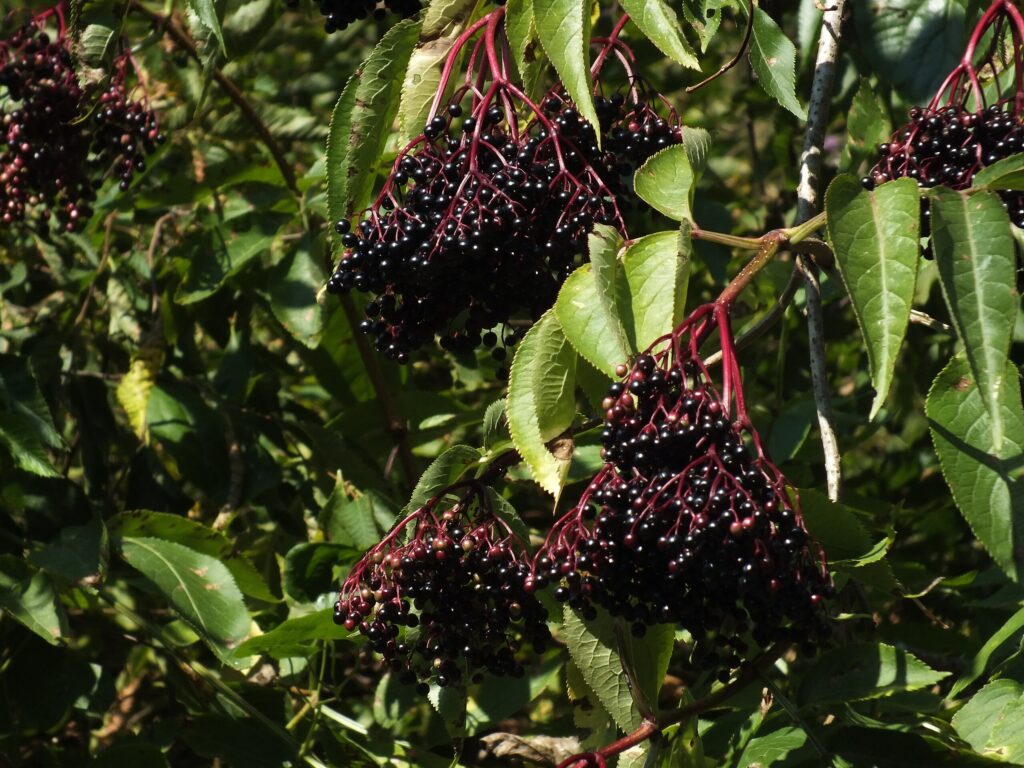
The ripe fruits are depurative and laxative and contain vitamins A and C. The juice, like all other parts of the plant, is used phytotherapeutically. It can also be used to dye natural fibers in various shades of purple. It was once used as a coloring agent for leather and, until a few decades ago, was used to produce ink. Green dye can be obtained from the leaves and black dye from the bark.
The very ripe fruits can be eaten but are generally used to make jams and syrups. The most famous drink made with elderberries is the “Sambuca Romana.”
The ancient “friendship” between our species and the Elderberry is evidenced by the remains of Elderberry berries found in Neolithic settlements! Its wood has long been valued as a raw material for shovels and other agricultural tools, and the young branches, deprived of the pith, have provided generations of imaginative children with blowpipes and whistles.
Its extreme hardiness makes it highly appreciated for any effort to restore bare or degraded land.
Black elder drupes are an important food source for numerous species of birds: from the Wood Pigeon to the Robin, the Black Redstart and the Blackcap; from the Blackbird to the Fieldfare and the Thrushes, to the Chiffchaffs and the Tits. Even Starlings, Sparrows, Chaffinches, Bramblings, Redpolls, Hawfinch, and Golden Orioles love these fruits very much, just like larger species such as the Jay, the Magpie, and the Crows.
The second Viburnum that ripens at the end of July is the Lentaggine (Viburnum tinus), also known as Laurustinus, Alloro-tino, Laurel-tino, Laurentino, a woody plant with a shrubby or tree-like habit, widespread on the edges of broadleaf forests, very common in the Mediterranean Maquis from 0 to 800 m. Like all the species that make up the Mediterranean Maquis, it is highly hardy and can even adapt to environments with severe summer drought.
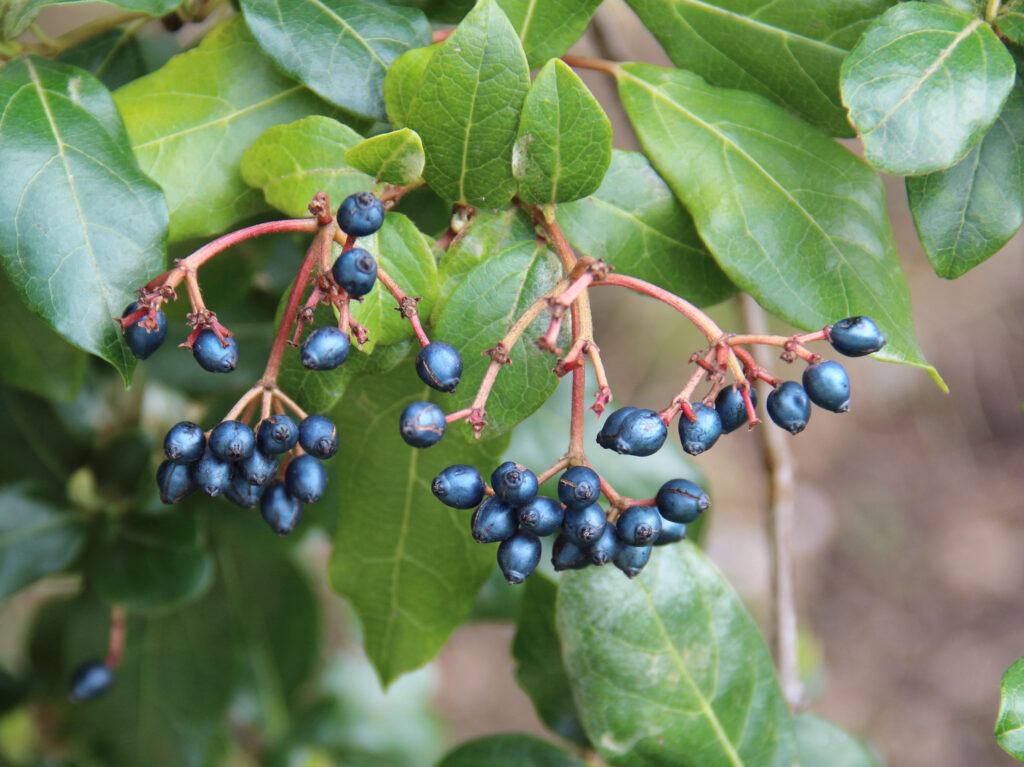
The erect stem has opposite branches that form a dense and regular crown. The leaves are leathery and persistent, with an ovate-elliptical blade rounded at the base and a sharp apex. They are dark green and shiny on the upper side and lighter and tomentose on the lower side. The inflorescences are corymbs with two or three orders of small, white or pink, odorless flowers. The fruits are ovoid drupes about half a centimeter in size, bluish-metallic in color, and remain persistent for a long time.
The fruits are toxic due to the presence of viburnin, although they were once used in pharmacopoeia. It is currently a plant of ornamental interest for its evergreen leaves and characteristic umbrella-shaped inflorescences with long-lasting flowers. It is suitable for growing in pots or to form dense hedges that are a refuge for numerous species of birds, or isolated to generate choreographic effects or on terraces to form closing hedges. Its hard and compact wood is used for inlays and objects.
Credits
Author: Anna Lacci is a science communicator and expert in environmental education, sustainability, and place-based teaching. She is the author of documentaries, nature books, workbooks, interdisciplinary teaching resources, and multimedia informational materials.
Translated by Maria Antonietta Sessa

